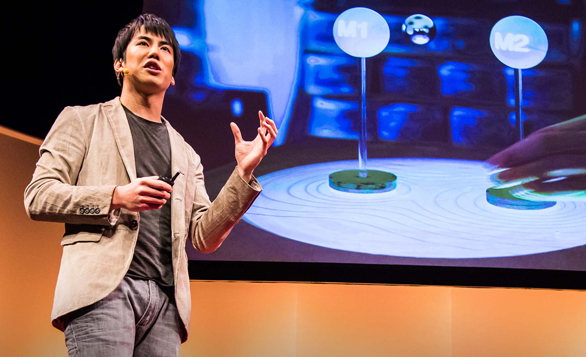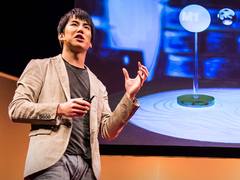
TED Fellow Jinha Lee speakers at TED2013 about collapsing the boundary between humans and computers.
“Throughout the history of computers, we’ve been striving to shorten the gap between us and digital information, the gap between our physical world and the world in the screen,” interface designer Jinha Lee says in today’s talk.
 Jinha Lee: Reach into the computer and grab a pixel
Lee points out that the gap has become shorter and shorter—it’s now “less than a millimeter, the thickness of a touchscreen glass,” he says. But his goal is to dissolve the boundary completely. In this talk, given at TED2013, he shows off a tool he invented that penetrates into a screen. He also reveals a technology that creates a digital workspace between a keyboard and translucent screen, allowing us to reach into digital worlds with our hands. And his wild ideas don’t stop there.
Jinha Lee: Reach into the computer and grab a pixel
Lee points out that the gap has become shorter and shorter—it’s now “less than a millimeter, the thickness of a touchscreen glass,” he says. But his goal is to dissolve the boundary completely. In this talk, given at TED2013, he shows off a tool he invented that penetrates into a screen. He also reveals a technology that creates a digital workspace between a keyboard and translucent screen, allowing us to reach into digital worlds with our hands. And his wild ideas don’t stop there.
“If you remove this boundary,” says Lee, “the only boundary left is our imagination.”
Of course, we’ve been questioning what it means, on a deeper level, to shorten the gap between our digital technologies and ourselves since computers were invented, in terms of not only interacting with computing devices, but also making them ever more human. Here, media that either exemplify or address our increasing entwinement with our technologies.
-
 Sergey Brin: Why Google Glass?
At TED2013, Google co-founder Sergey Brin explained the logic behind what is arguably the most radical example of dissolving the boundary between us and computers: Google Glass. A voice-activated headset, Glass allows you to search the web, take a photo or video, send a message, make a call—basically, do anything you can do with your smartphone, but without taking your eyes off whatever’s in front of you. (Read what the TED staff thinks after roadtesting Google Glass.)
Sergey Brin: Why Google Glass?
At TED2013, Google co-founder Sergey Brin explained the logic behind what is arguably the most radical example of dissolving the boundary between us and computers: Google Glass. A voice-activated headset, Glass allows you to search the web, take a photo or video, send a message, make a call—basically, do anything you can do with your smartphone, but without taking your eyes off whatever’s in front of you. (Read what the TED staff thinks after roadtesting Google Glass.)
. - Radiolab’s episode “Talking to Machines,” which aired in 2011, remains a classic and features several stories in which computers have so successfully imitated human beings that, well, it’s a little freaky. The episode begins with the story of a man who fell in love with a chatbot that learns from every conversation it has. There’s also a consideration of just why we feel for Furby, that cute little robot animal with personality. (Read the TED Blog’s exploration of toys that blur the line between pet, robot and friend.) And finally, Jon Ronson (watch his talk) interacts with Bina48, a robot modeled after a real woman.
. - Studio 360 also dealt with computers’ human capacity in the 2011 episode “Are computers creative?” that investigated the question of whether computers can make art. The episode introduces us to AARON, a computer program that’s been painting for four decades and a filmmaker who opted for an algorithm over an editor.
. - One of the first attempts to quantify and qualify the difference between humans and computers is known as the Turing test. Invented in 1950 by Alan Turing, the test involves a scientist conversing via text with a human and with a computer, and trying to deduce which is which. For more on this test, take a look at the work of Brian Christian, who recounts his own participation in the annual Turing test competition in his book, The Most Human Human: What Artificial Intelligence Teaches Us About Being Alive.
. - For a bit of time travel, read the 2002 New York Times piece “Human or Computer?” on the invention of Captcha, that modern-day Turing test that uses the ability to read distorted text as the marker of whether a user is a human or a bot.
. - The TED Radio Hour episode “Do we need humans?” examines the possibility of a robot-reliant future of humanity, looking at how interactions between humans will change as technology accelerates. The episode includes interviews with four TED speakers who explore ideas of lifelike robots and connectivity in their talks: Sherry Turkle (watch her talk), Cynthia Breazeal (watch her talk), Andrew McAfee (watch her talk) and Abraham Verghese (watch his talk).
. -
 Sebastian Thrun: Google's driverless car
If Google Glass aims to seamlessly integrate technology into our daily interactions, another Google product—the self-driving car—addresses a different goal: using robots to complete previously human responsibilities. At TED2011, Sebastian Thrun explains his belief in the car’s potential to save lives by avoiding accidents, reveals test-drive footage and shares that — at that point — Google’s self-driving cars had driven more than 140,000 miles so far. (Read the TED Blog’s 5 fascinating cars of the future.)
Sebastian Thrun: Google's driverless car
If Google Glass aims to seamlessly integrate technology into our daily interactions, another Google product—the self-driving car—addresses a different goal: using robots to complete previously human responsibilities. At TED2011, Sebastian Thrun explains his belief in the car’s potential to save lives by avoiding accidents, reveals test-drive footage and shares that — at that point — Google’s self-driving cars had driven more than 140,000 miles so far. (Read the TED Blog’s 5 fascinating cars of the future.)
. - Along similar, but possibly more unsettling, lines: the recent article in The Atlantic, “The Robot Will See You Now,” which looks at evidence that robots might be better at some things than doctors. IBM’s Watson, the supercomputer that famously took down Ken Jennings on Jeopardy (watch his TED Talk about the experience), is now examining medical case histories at Memorial Sloan-Kettering hospital in New York — and doing an incredible job of recommending tests and treatments, based on the latest research.
Comments (11)
Pingback: TED – MAN vs. TECHNOLOGY | madelENDS
Pingback: Essay #3: The “obvious” | English 101 @ LLCC: An Introduction to Academic Writing
Pingback: TED Talk Response – Re: Jinha Lee’s talk on the shrinking boundaries between humans and computers | Wandering Quest for Inspiration